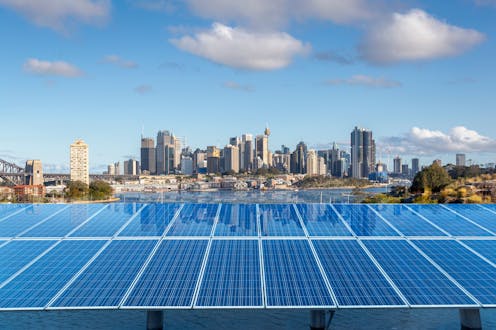
It’s now very likely Australia will be announced as the host of the COP31 global climate talks in 2026 alongside Pacific nations. This would be a very big deal. The talks run for a fortnight and draw tens of thousands of delegates. It would be the largest diplomatic summit Australia has ever held, with satellite events in Pacific nations.
A decision – made by other countries in our United Nations regional grouping – is expected in November. Sydney, Adelaide and Brisbane have already signalled interest in hosting.
Hosting these talks can boost national fortunes. When the United Kingdom hosted the talks in 2021, it was their biggest international success after the pain of Brexit, winning friends and influence.
The talks would bring global attention – and heighten expectations. Playing host would cement Australia’s place in the emerging net-zero economy, galvanise the federal government’s green industry plans and rapidly build the trade and diplomatic ties needed to develop new markets for clean energy goods.
In a Climate Council and Smart Energy Council report released today, we lay out how important these talks would be to shift Australia away from fossil-fuel exports, switch from mining dirty to mining clean, rebuild our position in the acutely climate-aware Pacific and secure new economic opportunities in Asia.
A talkfest – but a vital one
Critics of these talks often frame them as a bloated international talkfest where nothing actually happens.
But consider the problem. Almost 200 countries with very different interests send representatives. Island nations in the Pacific don’t profit from fossil fuel sales, but face the loss of their land to the sea and their reefs to the heat. Major fossil fuel exporters, however, have an incentive to go slow.
As extreme weather and marine heating intensify, the climate crisis is becoming more visible everywhere. People are being forced from their homes in Tuvalu and Lismore alike. A third of Australians worry extreme weather may force them to permanently relocate. We all have a shared interest in going fast.
Progress is finally happening. After the crucial 2015 Paris Agreement, COP talks have been characterised by negotiation over how to cut greenhouse gas emissions and shift away from fossil fuels. At these talks, countries also assess progress toward their shared goals and wealthier nations may pledge support to help developing countries deal with climate impacts.
But they are more than this. They are also a de facto global trade fair, bringing together major players in clean energy industries and providing a platform to attract global investment in local projects. As host, Australia could shape the agenda for important informal discussions alongside the formal meetings.
There’s already interest from Brisbane, Adelaide and Sydney in hosting the talks.
Major sporting events such as the Commonwealth Games often require custom-built facilities. But the COP talks just need good conference centres, hotels and transport. Hosting the UN talks could deliver the chosen city a windfall of between A$100-210 million, equivalent to about four AFL grand finals. Hosting the 2021 talks added an estimated A$1 billion to the overall UK economy.
All signs suggest the Australia/Pacific bid is likely to be chosen. The 2026 COP host will be decided by countries in the ‘Western Europe and Other’ regional grouping at the UN (COP hosting is rotated among regions). There’s already public support from the United States, United Kingdom, France, Germany, New Zealand, Switzerland and Canada. The other bidder, Türkiye, does not currently have public backing.
Australia’s bid has widespread domestic support. A recent Lowy poll found 70% of Australians are supportive. Business groups are also supportive, while major banks are already working to unlock private sector investment in anticipation.
What would it mean for Australia-Pacific relationships?
Pacific island countries see climate change as their “single greatest” threat. Leaders see climate change impacts — stronger cyclones, devastating floods, rising seas, dying reefs and ocean acidification — as more tangible and immediate threats than geopolitical manoeuvring.
Pacific nations have long worked together at COP talks to drive global climate action. They have earned a reputation for sticking to the science, and were instrumental in securing landmark climate deals like the Kyoto Protocol and the Paris Agreement.
On climate, Australia can now bring more to the table. Already, 40% of the main grid runs on clean energy. That figure will likely reach 80% by 2030. Australia is funding a range of Pacific climate adaptation programs.
A key tension remains, however. Pacific island nations have urged major powers to phase out fossil fuel production, while Australia has recently emerged as one of the world’s largest fossil fuel exporters.
Co-hosting COP31 could help this tension by signalling Australia’s shift from fossil fuel heavyweight to clean energy powerhouse.
New economic opportunities in Asia (and beyond)
Global demand and investment is shifting from fossil fuels to clean energy commodities.
To reach net zero, the International Energy Agency suggests fossil fuels will drop from 80% of total energy supply in 2022 to 20% by 2050. Demand for coal, oil and gas is now expected to decline this decade.
Japan, China and South Korea buy over two-thirds of Australia’s coal and gas exports. But Japan and Korea now plan to double clean energy generation by 2030, while China commissioned as much solar in 2023 as the whole world did in 2022.
These shifts have huge implications. Last week, the Climate Change Authority released modelling showing Australia’s fossil fuel exports would fall 60% by 2050 if we and our trading partners take strong climate action – while our other mineral and metal exports would surge by 65%.

If the Australia/Pacific COP bid gets up as expected, the federal government must begin shaping the agenda now.
Wesley Morgan is a fellow at the Climate Council and research fellow at the Griffith Asia Institute
This article was originally published on The Conversation. Read the original article.







